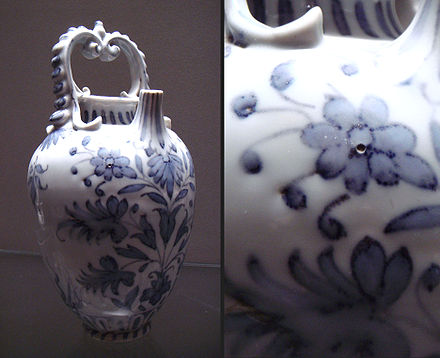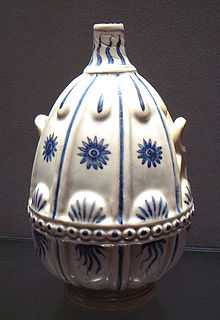- Medici porcelain
-
 Medici Porcelain Works, Bottle, c. 1575–87, with pitted texture detail; Soft Paste Porcelain; OA 2734, Musée du Louvre, Paris.
Medici Porcelain Works, Bottle, c. 1575–87, with pitted texture detail; Soft Paste Porcelain; OA 2734, Musée du Louvre, Paris.
Medici porcelain was the first successful attempt in Europe to make imitations of Chinese porcelain, although it didn't managed to make true porcelain. The experimental manufactory housed in the Casino of San Marco in Florence existed between 1575 and 1587 under the patronage of Francesco I de' Medici, Grand Duke of Tuscany. A painted mark of Brunelleschi's dome and a capital letter F appear on the underside of some pieces; others bear the Medici palle, the balls that are the Medici heraldic charge. Never a commercial venture, Medici porcelains were sometimes given as diplomatic gifts; for example, surviving pieces bear the arms of Philip II of Spain.
Contents
History and Manufacture
Giorgio Vasari reported in the 1568 edition of his Vite that Bernardo Buontalenti was currently at work on discovering the art of porcelain, but there is no sign that he was successful. The first successes were finally reported in 1575 by the Venetian ambassador Andrea Gussoni, who mentioned in his brief to the Serenissima that Francesco discovered the means of making "the porcelain of India," (i.e. the East Indies).[1] Gussoni mentioned in particular the four qualities that made porcelain desirable, apart from its exotic rarity:
“ its transparency, hardness, lightness and delicacy; it has taken him ten years to discover the secret, but a Levantine showed him the way to success.[2] ” However, the entire project was ultimately relatively short-lived; the high-firing temperature pushed sixteenth century technical capability to its limit, resulting in exorbitant production costs. There are no references to Medici porcelain manufacture securely dated after Francesco's death in 1587.[3]
The body of Medici porcelain ware is a type of soft-paste porcelain, composed of white clay containing powdered feldspar, calcium phosphate and wollastonite (CaSiO3), with quartz. The glaze contains calcium phosphate, indicating that the Islamic technique of using calcined bone to make an opaque white glaze was adopted.[4] The result is translucent but slightly glassy in feel. Following the precedents of classic Chinese blue and white porcelain, decorations were painted in underglaze blue, which resulted in a range of hues when fired—from a bright cobalt blue (such as a flask in the National Gallery of Art[5]) to gray (such as the bottle detail at right). Some pieces have outlines traced in manganese.[6]
Body shapes are adapted from maiolica ceramics and silver models; they range from the largest basins and ewers, chargers and plates, to the smallest cruets. Decorative motifs are executed in imitation of Chinese blue-and-white wares, or of Turkish İznik ceramics, or more rarely in imitation of maiolica grottesche ornament. Both Chinese and Turkish ceramics had been represented in the Medici family collections for over a century; for example, one prized possession of the family was a gift from the Mamluk Sultan of Egypt who sent Lorenzo de' Medici "large vessels of porcelain, the like of which has never been seen" in 1478. [7]
Legacy
When Francesco died, his younger brother Cardinal Ferdinando de' Medici inherited the position of Grand Duke. Ferdinando brought his prized Chinese and Medici porcelains back with him to Florence from the Villa Medici in Rome, along with his paintings and treasured Roman antiquities. But with the ubiquity of European soft-paste and hard-paste porcelains in the eighteenth century, the Medici heirs in the House of Lorraine came to value less and less the imperfect Medici porcelains, with their minute firing cracks and bubbled glazes. In 1772 an auction in the Palazzo Vecchio of objects from storage dispersed the Medici porcelains conserved in Tuscany. The venture disappeared from history until interest revived after the mid-nineteenth century. The 1588 inventory drawn up after Francesco's death listed 310 pieces.[8] Today only some sixty or seventy pieces are known to survive.[9]
The next successful European attempt to make soft-paste porcelain would come from the Rouen manufactory in France, in 1673.
Notes
- ^ Marco Spallanzani, Ceramiche alla Corte dei Medici nel Cinquecento, (Pisa: Scuola Normale Superiore, and Modena: Franco Cosimo Panini, 1994), p. 69.
- ^ Cristina Acidini Luchinat, The Medici, Michelangelo, and the Art of Late Renaissance Florence exhibition catalogue, Florence, 2002, cat. nos 101-05, pp 247ff.
- ^ Cristina Acidini Luchinat, p. 248.
- ^ According to on-site Raman spectroscopic analyses performed at the Musée National de Céramique, Sèvres, reported in Ph. Colomban, V. Milande, H. Lucas, "On-site Raman analysis of Medici porcelain", Journal of Raman Spectroscopy, 35.1 (2003:68-72).
- ^ National Gallery of Art: Widener Collection 1942.9.354
- ^ A single piece decorated in green and yellow is at Brunswick and another conserved in a private collection.
- ^ Spallanzai, Ceramice, pp. 55-56. See also the National Gallery website: National Gallery, Washington DC: Medici porcelain flask
- ^ Marco Spallanzani, "Medici Porcelain in the Collection of the Last Grand-Duke" The Burlington Magazine 132 No. 1046 (May 1990, pp. 316-320) p. 317.
- ^ For a list of surviving pieces of Medici Porcelain see G. Cora and A. Fanfani, La porcellana dei Medici (Milan) 1986.
References
- G. Cora and A. Fanfani, La porcellana dei Medici (Milan) 1986.
- Giuseppe Liverani, Catalogo delle porcellane dei Medici, in series Piccola Biblioteca del Museo delle Ceramiche in Faenza: II (Faenza) 1936.
- Arthur Lane, Italian Porcelain London 1954.
External links
- National Gallery, Washington DC: Medici porcelain flask
- Metropolitan Museum of Art: Medici porcelain ewer
Porcelain China Chinese porcelain · Chinese export porcelain · Chinese influences on Islamic pottery
Types: Proto-celadon (16th century BCE) · Celadon (1st century) · Yue (2nd century) · Jingdezhen (6th century) · Sancai (8th century) · Ding (10th century) · Qingbai (12th century) · Blue and white (14th century) · Blanc de Chine (14th century) · Kraak (16th century) · Swatow (16th century) · Kangxi (17th century) · Famille jaune, noire, rose, verte (17th century) · Tenkei (17th century) · Canton (18th century)Korea Types: Joseon (14th century)Japan Europe French porcelain · Chinese porcelain in European painting
Types: Fonthill Vase (1338) · Medici (1575) · Rouen (1673) · Nevers · Saint-Cloud (1693) · Meissen (1710) · Chantilly (1730) · Vincennes (1740) · Chelsea (1743) · Oranienbaum (1744) · Mennecy (1745) · Bow (1747) · Nymphenburg Porcelain Manufactory (1747) · Plymouth (1748) · Worcester (1751) · Frankenthal Porcelain Factory (1755) · Sèvres (1756) · Derby (1757) · Wedgwood (1759) · Wallendorf (1764) · Etiolles (1770) · Limoges (1771) · Clignancourt (1775) · Royal Copenhagen (1775) · Revol (1789) · Herend Porcelain Manufactory (1826) · Zsolnay (1853)Technologies People Ehrenfried Walther von Tschirnhaus · Johann Friedrich Böttger · Francois Xavier d'Entrecolles · Dmitry VinogradovCollections British Museum (London): Asia Department / Percival David Foundation · Dresden Porcelain Collection · Gardiner Museum (Toronto) · Kuskovo State Museum of Ceramics (Moscow) · Musée national de Céramique-Sèvres (Paris) · Musée des Arts Décoratifs (Paris) · Palace Museum (Beijing) · Topkapı Palace (Istanbul) · Victoria and Albert Museum (London) · Worcester Porcelain MuseumPeople Institutions Buildings Related Medici family tree · Medici lions · Venus de' Medici · Medici Vase · Medici Fountain · Medici porcelainCategories:- Porcelain
- Italian culture
- Italian pottery
Wikimedia Foundation. 2010.






